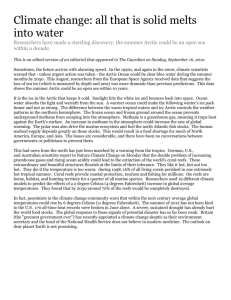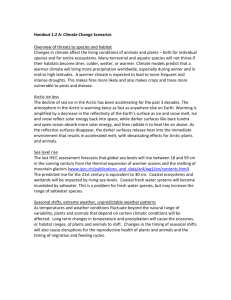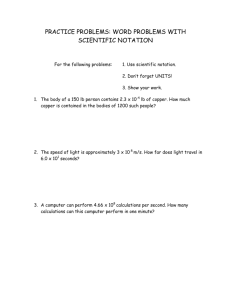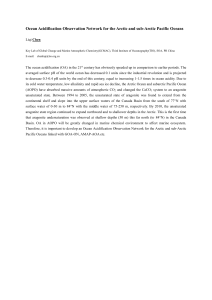About the Arctic Ocean
advertisement
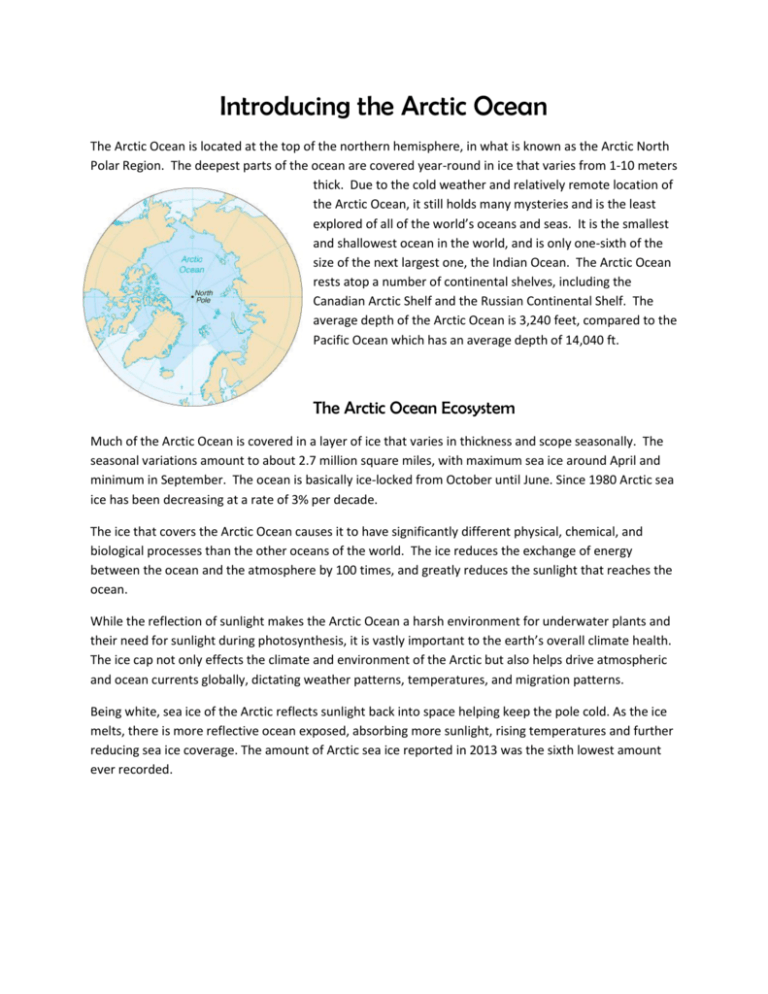
Introducing the Arctic Ocean The Arctic Ocean is located at the top of the northern hemisphere, in what is known as the Arctic North Polar Region. The deepest parts of the ocean are covered year-round in ice that varies from 1-10 meters thick. Due to the cold weather and relatively remote location of the Arctic Ocean, it still holds many mysteries and is the least explored of all of the world’s oceans and seas. It is the smallest and shallowest ocean in the world, and is only one-sixth of the size of the next largest one, the Indian Ocean. The Arctic Ocean rests atop a number of continental shelves, including the Canadian Arctic Shelf and the Russian Continental Shelf. The average depth of the Arctic Ocean is 3,240 feet, compared to the Pacific Ocean which has an average depth of 14,040 ft. The Arctic Ocean Ecosystem Much of the Arctic Ocean is covered in a layer of ice that varies in thickness and scope seasonally. The seasonal variations amount to about 2.7 million square miles, with maximum sea ice around April and minimum in September. The ocean is basically ice-locked from October until June. Since 1980 Arctic sea ice has been decreasing at a rate of 3% per decade. The ice that covers the Arctic Ocean causes it to have significantly different physical, chemical, and biological processes than the other oceans of the world. The ice reduces the exchange of energy between the ocean and the atmosphere by 100 times, and greatly reduces the sunlight that reaches the ocean. While the reflection of sunlight makes the Arctic Ocean a harsh environment for underwater plants and their need for sunlight during photosynthesis, it is vastly important to the earth’s overall climate health. The ice cap not only effects the climate and environment of the Arctic but also helps drive atmospheric and ocean currents globally, dictating weather patterns, temperatures, and migration patterns. Being white, sea ice of the Arctic reflects sunlight back into space helping keep the pole cold. As the ice melts, there is more reflective ocean exposed, absorbing more sunlight, rising temperatures and further reducing sea ice coverage. The amount of Arctic sea ice reported in 2013 was the sixth lowest amount ever recorded. Under the surface of the Arctic Ocean, the topography of the Arctic Ocean is characterized and shaped by a large underwater ridge known as the Lomonosov Ridge. The ridge divides the Ocean basin into two separate regions, the Eurasian Basin and the Ameriasian Basin. The majority of the Arctic Ocean floor is made up of abyssal plains, which are flat areas of terrain that fall between 3,000 and 6,000 meters deep. It was long believed by scientists that abyssal plains are vacant wastelands where not a lot of life can survive, but it has been recently discovered that they are in fact rich with microbial life. Researchers however still do not have a lot of information on the ecosystem structure or function due to the remote location of their study area. The non-microbial life in the Arctic Ocean’s abyssal plain consists of different species of worms, crustaceans, mollusks, sponges, starfish and other bottom-feeders. The Arctic Ocean surface is scarred by tectonic activity and there are many crevices and faultblock ridges with gigantic rocks that have been broken off due to tectonic plates shifting. The deepest point in the Arctic Ocean is 17,880 feet, known as the Litke Deep, located in the Eurasian basin. America’s Arctic Ocean America’s Arctic Ocean is located off the coast of Alaska and is comprised of two main seas: the Chukchi and the Beaufort. Divided by Barrow, located on the northern tip of Alaska, the Beaufort and Chukchi Seas provide critical habitat for a number of ocean mammals, migrating birds and people who live along the coast. The Beaufort Sea stretches northeast from Barrow, bordering both Alaska and Northwestern Canada, while the Chukchi Sea lies west of Barrow and extends towards Russia. The Chukchi is the Arctic’s westernmost sea and supports approximately one-tenth of the world’s remaining polar bear population. It is also part of the spring and fall migration routes for beluga and endangered bowhead whales, a feeding area for gray and finback whales and Pacific walrus, important habitat for migratory birds and includes critical habitat for threatened spectacled eiders. Additionally, the U.S. Fish and Wildlife Service determined that the essential physical and biological features for polar bears include critical sea-ice habitat encompassing all offshore areas under U.S. jurisdiction over the continental shelves of the Beaufort and Chukchi Seas. The Beaufort and Chukchi Seas are central to life in coastal communities, provide important habitat for countless species of wildlife, and play a vital role in regulating the world’s climate. Unfortunately, these critical waters are under attack from two separate threats, climate change and oil and gas exploration. The Arctic is already warming at about twice the rate of the rest of the world. The scientific consensus is that this warming results from human-caused emissions of greenhouse gases, particularly carbon dioxide. The Arctic polar ice cap as a whole is shrinking substantially, and summers in the Arctic could become ice-free by the end of the century. The decrease in summer sea ice has been linked to sea level rise and extreme weather patterns all over the country. The changes in the Arctic have implications for the rest of the world. Loss of sea ice cover in the fall is already associated with changing weather patterns across the northern hemisphere with consequences for agriculture and losses of life and property from extreme weather events. Drilling for oil in the Arctic Ocean will seriously undermine our efforts to fight climate change. It not only pumps pollution in the air, but it also puts black, heatabsorbing soot right onto the Arctic sea ice, further melting ice that is at its lowest ever-measured levels.

